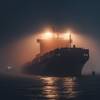The National Transportation Safety Board cited inadequate maintenance as the cause of the 1999 sinking of the amphibious passenger vessel, Miss Majestic, on Lake Hamilton in Hot Springs, Arkansas. Thirteen people were killed when the vessel sank. The Board's probable cause listed the lack of reserve buoyancy and inadequate Coast Guard oversight as contributing causes.
On May 1, 1999 the Miss Majestic, with 21 persons on board, entered Lake Hamilton as part of a regular tour. During the tour of the lake, water entered the hull through a loose rubber boot that provides the watertight barrier where the drive axel penetrates the hull. About 7 minutes into the lake tour the vessel sank by the stern, 60 feet to the bottom of the lake. Seven passengers and the operator managed to escape.
The Miss Majestic was built by the U.S. Army in 1944 and used as an amphibious landing vehicle, known as a DUKW, to transport personnel from ship to shore. DUKWs were not originally designed for passenger service and do not have adequate reserve buoyancy to remain afloat in the event of a breach of watertight integrity. Without reserve buoyancy, the Miss Majestic sank rapidly after flooding began. As a result the Safety Board has recommended that the U.S. Coast Guard along with the governors of New York and Wisconsin require that amphibious passenger vehicles provide reserve buoyancy through watertight compartmentalization, built-in flotation or other measures that will keep the vessel afloat and upright in the event of flooding.
Until reserve buoyancy retrofits are completed the Board recommended immediate actions to mitigate the danger for vessels without adequate reserve buoyancy including the removal of canopies during water operations or installation of a Coast Guard approved canopy that would not restrict the horizontal or vertical escape of passengers; closing unnecessary access plugs; reduction of through-hull penetrations to the minimum size needed for operation; and installation of independently powered electric bilge pumps.
The Board made an additional recommendation that on vehicles without adequate reserve buoyancy, where canopies have been removed, the Coast Guard require passengers to wear life jackets. The Board does not recommend that passengers wear life jackets if the canopy has not been removed.
The Board's investigation also discovered limited guidance for Coast Guard inspectors in charge of inspecting DUKW boats. At the time of the Miss Majestic accident the Coast Guard had no uniform, nationwide inspection policies for DUKWs. The Marine Safety Office (MSO) in charge of inspecting the Miss Majestic had no written policy for DUKW inspections and although local MSOs in Chicago and St. Louis had independently developed inspection standards, the policies were not coordinated through headquarters or disseminated to other local MSOs. The final recommendation made in the Board's report asks the Coast Guard to develop inspection guidance and standards for all types of amphibious passenger vehicles similar to the Navigation and Vessel Inspection Circular 1-01 that currently applies only to DUKWs.
Subscribe for
Maritime Reporter E-News
Maritime Reporter E-News is the maritime industry's largest circulation and most authoritative ENews Service, delivered to your Email five times per week










